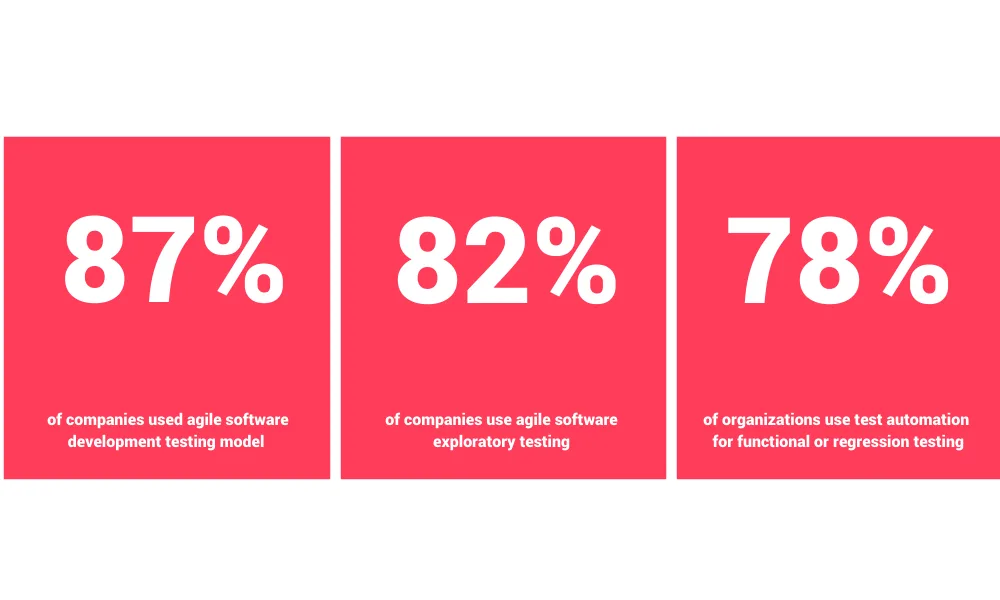
The global march toward digitalization has accelerated dramatically in practically every sector in the last two decades. It has caused software solutions to become more prevalent and take up more space in our lives. As a result, due to worries about things like security, efficiency, speed, and prices, there has developed a huge interest in software quality. We will go into great detail about software quality assurance in this blog post.
There is a huge market need for high-quality items in the current IT industry. Tech experts devised a solution by implementing many quality assurance practices throughout the software development cycle to achieve such high standards. Thus, the scope of software quality assurance expands along with the need for high-quality goods.
So, it is impossible to ignore the necessity for software quality assurance testing across various industries. Foreseeing a product being introduced to the market without being functionally tested is conceivable. If the customers are not pleased with the quality of the products, this can only result in undesired problems or difficulties.
A software project’s lifespan is extensive, encompassing numerous stages, responsibilities, and professionals. No matter how precise and committed each team may be, there will eventually be small mistakes in all of those elements. These minor mistakes lead to unanticipated problems and difficulties, and frequently communication channels become entangled.
Once the software is in use, a small defect that was previously there can grow into a significant one. These issues can cost a business money, confidence, and clients. How to avoid this issue? How to launch the finest product that drives revenue and customer satisfaction without putting much effort?
The answer is Quality Assurance (QA).
A crucial element of software development has been software quality assurance for many years. QA enables developers and testers to work more productively, collaborate more effectively, automate procedures, and view the larger picture. Want to know more about it? In this post, we summarise our vision for QA quality assurance and provide definitions for the idea, process, methods, and potential of software QA. So, let’s get started.
Defining Software Quality Assurance
Software quality assurance (SQA), to put it simply, is a process to guarantee the caliber of a software product. It includes a variety of strategies, tools, and techniques that support software development processes.
SQA testing uses well-defined standard operating procedures to guarantee the functioning and dependability of software. The entire software development process is paralleled by it. Software quality assurance, in other words, helps the development team foresee problems and ensure results that are up to par.
Let’s understand the term more clearly with an example.
Any software development project that experiences errors or blunders will suffer financial, time, and productivity losses. For instance, Starbucks lost millions of dollars in sales in 2015 due to a register problem, but on the plus side, customers were thrilled because they received free coffees.
Missing out on thorough SQA testing has detrimental effects on a firm, even if you are one of those people receiving free goods for software errors. Starbucks is a well-known company with a global presence. They should learn from this error. They could, however, afford this significant budgetary loss. The question is: Can your business afford such software production delays and mistakes? No, right?
Different Stages of Software Quality Assurance
A pear’s size, shape, ripeness, and lack of obvious bruising can all be used to assess a fruit’s quality at the point of purchase. You won’t know if the pear is actually that excellent until you take the first taste, though. Even a pear with the best appearance could taste bad or contain a worm.
Almost any product falls under this category, whether it be a tangible good or a piece of software. For example, a website you find online might appear fine at first, but as you scroll down, switch to a different page, or attempt to send a contact request, it may exhibit some design errors and flaws.
Quality control is crucial in every industry where an end-user product is manufactured. However, a rotten pear won’t harm you as much as a self-driving vehicle with subpar autopilot software. A single error in an EHR system could endanger a patient’s life, but a poorly performing eCommerce website could cost its owner millions of dollars in income.
This is why quality assurance is necessary. Basically, 5 main stages make up the QA process: discovering, planning, designing, executing, and improving.
Stage 1: Discover and Review the Requirements
Parallel to the documentation creation, QA engineers begin working on the project. They examine the prerequisites and supporting paperwork for:
- Completeness
- Redundancies
- Clarity
- Consistency
- Executable
- Verifiability
Consider using specialized software for reviewing documentation for this step. You can compile all relevant materials used for the entire project and keep an internal knowledge base. Every team member may view the changes as soon as any requirements or documents are modified, added, updated, or removed.
Stage 2: Plan and Prepare the Taste
Once the specifications have been defined, it’s time to start developing test cases, which specify QA engineers’ procedures to ensure the program works as intended. You can also utilize specialized tools for writing test cases if the volume of these cases ends up being somewhat large. Both programs enable the construction and adjustment of tests and the use of metrics to monitor outcomes.
Stage 3: Test Design
In a software development project, the primary goal of the QA team is to design a workable long-term plan. In addition, it will direct Quality Control teams, assist testers and developers in adhering to the best coding practices, and allow for measuring results. Six steps make up the design phase:
- Analysis: The team evaluates the project’s constraints, technological and human resources, and product needs;
- Clarification: Definition of software acceptance criteria (what constitutes a “done” product);
- Outline: Creating QA documentation for the project is outlined.
- Identification: choosing a testing strategy (quality assurance tools, settings, automation, accountable team members, management techniques);
- Evaluation of the final state: locating areas that can be optimized continuously.
Defining software quality assurance testing activities include selecting pertinent testing types and organizing goals and KPIs for each;
A software quality assurance procedure is still in the design phase. The team will update their QA strategy as the project develops, look for methods to cut costs and length, and automate as many procedures as they can.
Stage 4: Execution
We must specify what will be tested as a starting point for the test execution. QA teams create test cases to attempt to address this query. A test case, in a nutshell, outlines the prerequisites, desired results, and postconditions of a particular test scenario intended to confirm that a feature satisfies the fundamental criteria.
Setting up the testing environment is the next step in the test execution process. This section’s major requirements are to ensure that the testing environment (hardware and software) is as similar to the end user’s actual environment as possible. For instance, a web application test environment should have a web server, database, operating system, and browser.
Stage 5: Fix the Issues
The responsible QA engineers are notified when a developer resolves a problem, and they confirm it. When no problem is found, the bug tracking system closes the ticket. According to this rule, no bug can be declared as fixed until it has been confirmed.
Methods Used in Quality Assurance
There are several different types of QA testing, all of which are essential to ensuring that your application is bug-free. In order to give you a thorough understanding of the testing process and how it enhances your application, product, or software, we’ve included the most important QA testing techniques below.
Actually, there are two kinds of Quality Assurance types,
- Functional testing
- Non-functional testing
Let’s understand each method in-depth.
Method 1: Functional Testing
Functional testing typically consists of four parts. Each one of them is shown below –
Unit testing: The unit testing approach involves testing each software module or component that goes into a system or application. The module’s developers often write these tests and test-driven enhancement techniques (for example, Agile, XP, or Scrum).
Integration Testing: In this stage of testing, unique modules or components that have successfully undergone unit testing are tested when combined to carry out specific functions and tasks (otherwise called scenario testing).
System Testing: Integrity testing is scaled up in system testing so that the entire framework is tested. The framework is tested as part of a normal system test to uncover previously unnoticed defects, stability concerns, and critical flaws.
Acceptance Testing: The final phase of functional software testing, known as acceptance testing, involves ensuring that all project or product requirements have been satisfied. Additionally, it guarantees that customers and end users have tested the framework to ensure it functions as expected and fulfills all of their specified requirements.
Method 2: Non-functional Testing
Following are the parts and types of non-functional testing,
Vulnerability Testing: Testing for vulnerabilities involves looking for security flaws and vulnerabilities that hackers could use on a website or application.
Compatibility Testing: Checking for compatibility between a product and the software and hardware it will use is a part of similarity testing.
Usability Testing: The software’s usability and intuitiveness are tested as part of the convenience testing process. This testing stage is to ensure that the end user can use it without experiencing any frustration or confusion due to its UI and design.
Performance Testing: Performance testing verifies that the device operates effectively across a range of user-influencing circumstances, from heavy load to insufficient battery power.
Examples of Quality Assurance Methods
Let’s go through some technical and scholarly examples and citation of quality assurance from Hindawi Journals,
1985: Therac-25 software: extreme radiation exposure
References: Wikipedia page and Computer Magazine Study
Patients are in grave danger due to a number of technical flaws and poor standards of care. Poor failure management, a lack of integration tests, using legacy code improperly, and overflow were some of the causes.
1999: Mars Polar Lander crashed in 1999.
Reference: NASA Mission
After misinterpreting a vibration, the thrust engine switched off too soon while the aircraft was in descent. As a result, the testing scope may have been expanded to include this case.
2008: Problems with Heathrow T5 on the first day
Reference: British Airways’ explanation of Terminal 5’s problems.
Debug code left in the release version, load tests that were postponed or canceled, and massive mishandling of luggage all resulted in flight cancellations.
Continuous quality monitoring is helpful to prevent a “project deadline rush” and ensure that tests and code quality are verified early and frequently.
Parting Words
While mistakes in human creations are unavoidable, they can cost a lot. When a software product malfunctions due to a human mistake, it may result in a buildup of technical debt for the client and the organization, which may result in the failure of the software project. It is impossible to stress how important high-quality software is.
While preserving application security, a quality approach to software development helps organizations save time and money. Then, these quality-driven companies can maintain pleased clients while building a solid name in the marketplace. Most importantly, high-quality software aids businesses in maintaining their position as leaders in a crowded industry.
At Elluminati, we follow the best techniques and methods before delivering the final product. So what are you waiting for? Hire an experienced QA tester to develop bug-free products.









